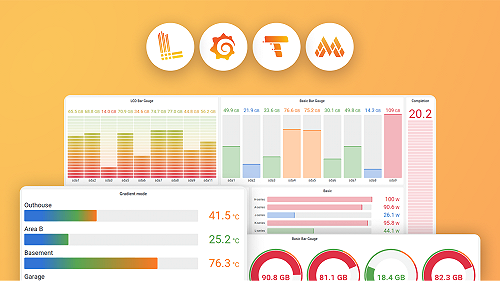This is documentation for the next version of Grafana k6 documentation. For the latest stable release, go to the latest version.
S3Client
Caution
In some cases, using this library's operations might impact performance and skew your test results.
To ensure accurate results, consider executing these operations in thesetupandteardownlifecycle functions. These functions run before and after the test run and have no impact on the test results.
S3Client interacts with the AWS Simple Storage Service (S3).
With it, you can do several operations such as list buckets, list objects in a bucket, or download objects from a bucket. For a full list of supported operations, see Methods.
Both the dedicated s3.js jslib bundle and the all-encompassing aws.js bundle include the S3Client.
Methods
Throws
S3 Client methods will throw errors in case of failure.
Examples
import { check } from 'k6';
import exec from 'k6/execution';
import http from 'k6/http';
import {
AWSConfig,
S3Client,
} from 'https://jslib.k6.io/aws/0.14.0/s3.js';
const awsConfig = new AWSConfig({
region: __ENV.AWS_REGION,
accessKeyId: __ENV.AWS_ACCESS_KEY_ID,
secretAccessKey: __ENV.AWS_SECRET_ACCESS_KEY,
});
const s3 = new S3Client(awsConfig);
const testBucketName = 'test-jslib-aws';
const testInputFileKey = 'productIDs.json';
const testOutputFileKey = `results-${Date.now()}.json`;
export async function setup() {
// If our test bucket does not exist, abort the execution.
const buckets = await s3.listBuckets();
if (buckets.filter((b) => b.name === testBucketName).length == 0) {
exec.test.abort();
}
// If our test object does not exist, abort the execution.
const objects = await s3.listObjects(testBucketName);
if (objects.filter((o) => o.key === testInputFileKey).length == 0) {
exec.test.abort();
}
// Download the S3 object containing our test data
const inputObject = await s3.getObject(testBucketName, testInputFileKey);
// Let's return the downloaded S3 object's data from the
// setup function to allow the default function to use it.
return {
productIDs: JSON.parse(inputObject.data),
};
}
export default async function (data) {
// Pick a random product ID from our test data
const randomProductID = data.productIDs[Math.floor(Math.random() * data.productIDs.length)];
// Query our ecommerce website's product page using the ID
const res = await http.asyncRequest('GET', `http://your.website.com/product/${randomProductID}/`);
check(res, { 'is status 200': res.status === 200 });
}
export async function handleSummary(data) {
// Once the load test is over, let's upload the results to our
// S3 bucket. This is executed after teardown.
await s3.putObject(testBucketName, testOutputFileKey, JSON.stringify(data));
}Multipart uploads
import crypto from 'k6/crypto';
import exec from 'k6/execution';
import {
AWSConfig,
S3Client,
} from 'https://jslib.k6.io/aws/0.14.0/s3.js';
const awsConfig = new AWSConfig({
region: __ENV.AWS_REGION,
accessKeyId: __ENV.AWS_ACCESS_KEY_ID,
secretAccessKey: __ENV.AWS_SECRET_ACCESS_KEY,
sessionToken: __ENV.AWS_SESSION_TOKEN,
});
const s3 = new S3Client(awsConfig);
const testBucketName = 'test-jslib-aws';
const testFileKey = 'multipart.txt';
export default async function () {
// List the buckets the AWS authentication configuration
// gives us access to.
const buckets = await s3.listBuckets();
// If our test bucket does not exist, abort the execution.
if (buckets.filter((b) => b.name === testBucketName).length == 0) {
exec.test.abort();
}
// Produce random bytes to upload of size ~12MB, that
// we will upload in two 6MB parts. This is done as the
// minimum part size supported by S3 is 5MB.
const bigFile = crypto.randomBytes(12 * 1024 * 1024);
// Initialize a multipart upload
const multipartUpload = await s3.createMultipartUpload(testBucketName, testFileKey);
// Upload the first part
const firstPartData = bigFile.slice(0, 6 * 1024 * 1024);
const firstPart = await s3.uploadPart(
testBucketName,
testFileKey,
multipartUpload.uploadId,
1,
firstPartData
);
// Upload the second part
const secondPartData = bigFile.slice(6 * 1024 * 1024, 12 * 1024 * 1024);
const secondPart = await s3.uploadPart(
testBucketName,
testFileKey,
multipartUpload.uploadId,
2,
secondPartData
);
// Complete the multipart upload
await s3.completeMultipartUpload(testBucketName, testFileKey, multipartUpload.uploadId, [
firstPart,
secondPart,
]);
// Let's redownload it verify it's correct, and delete it
const obj = await s3.getObject(testBucketName, testFileKey);
await s3.deleteObject(testBucketName, testFileKey);
}

